Yup we steal their butt biggest. 😝
I was thinking of plastic, 6 mil. Have some extra from the roof.
But I am pretty sure my ass hole goats would try to eat it. I layed some exrta shingles on a duck house the goats where climbing on. Was thinking it would help with their hoofs, the jack asses ate the shingles!🤦♀️
I used outdoor paint on the floor of the coop when we first built it. But I guess that doesn’t do squat.
My BFF layed tile in her coop, she had mini chickens. LOL
I will talk to the hubby and see what he says about rot proofing it better. I like that rubber liner idea for sure!
Do you know if I could find it at Home Depot or Lowe’s?
What do you mean you kept them elevated? Like with perches? My girl goats share the coop with chickens.
My goats will pee in the coop😡 So that so doesn’t help matters any at all!
If your goats eat shingles (seriously? haha) I can't think of any floor covering that they wouldn't eat. That rubber roofing is actually expensive, I just had a left over piece from when I bought a big piece for a pond liner. Linoleum is another cheap flooring (roll linoleum yummm) Maybe a second (sacrificial) wood floor.
I raised my sheds up with floor jacks and put concrete blocks under the wood joists so that instead of them being inches off the ground they had enough room to where there was plenty of air circulation and I could clean underneath them easily. Lots of leaves etc get blown underneath, trap moisture, and start rot.
If you have large animals like goats in with your chickens, make sure you have plenty of ventilation. In the winter this seems counter-intuitive, but the wet air from their respiration will actually make them colder. Just choose your vent placement so that there is not a draft blowing over the hens.
I had peacocks and hens living together in one shed, and just made a separate enclosure within the shed where they lived separate from the peacocks (the peacocks were in a loft over the chickens)
Maybe you could do a similar situation i couldn't get a good idea of what your shed is like from the picture.
Also, I would clean my coop every day and do a full down to the floor sweep out 2 or 3 times a month. Never had a problem with bird mites mold or flies.
Yeah we have thought of getting a linoleum rementent from a box store.
We have the coop up on cinderboxs, with pressure treat base boards.
We have a vent at the top of the door, and the coop door is only closed if by a fleece doggie door flap. So there is no straight breeze to hit any of the animals. I tried to block the breeze from the doggie door with another structure but I caused problems.
With all our snow it’s hard to keep moisture out. But we have had the coop for three years so it’s not to bad I guess.😕 Still sucks rocks!
We also have temps of -30°F to -40°F.
I tried not to have heat in the coop this past winter and I lost about 12 chickens including the pretty white rooster you see below. I always heat my coop, even if it’s just above freezing in the coop. It’s better then -30° or lower. Prior years when I heated I never lost a bird to the cold.
Was wondering if having the coop straight on the ground would be a good idea. So that we get the heat from the earth too. But I just don’t know.
The strange thing is we ended up with holes under the nesting boxes. Where only the hens lay. So I don’t get it. But in the summer, we open the door and put up their screen door.
This was awhile ago but the set up is the same.
I tried this, this past winter to keep the snow away from the door. It kinda helped.
I'm going to show you the way I handled my bird coop to deal with winter.
.JPG)
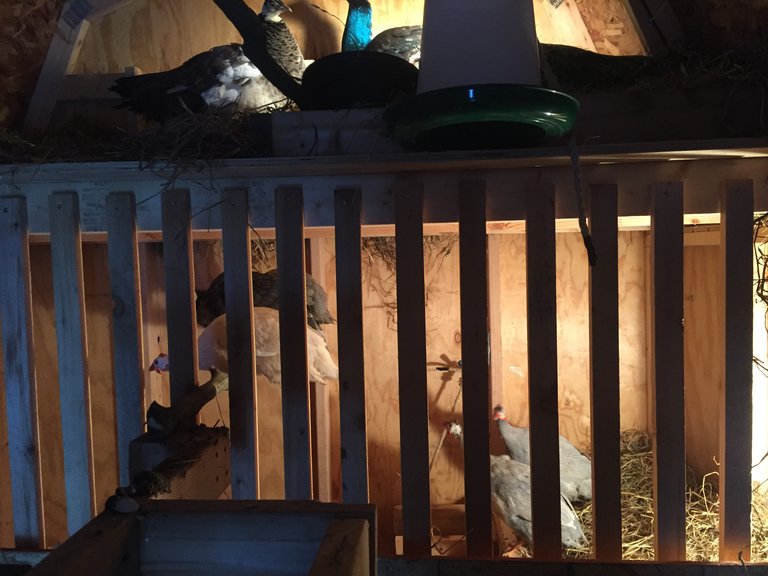

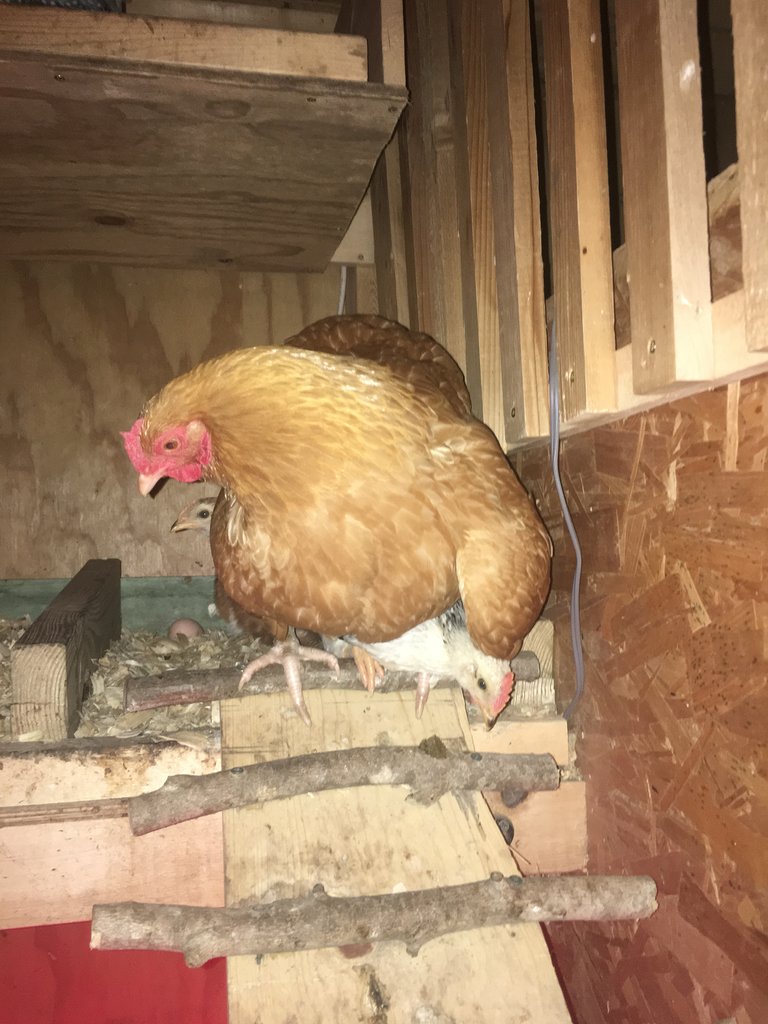
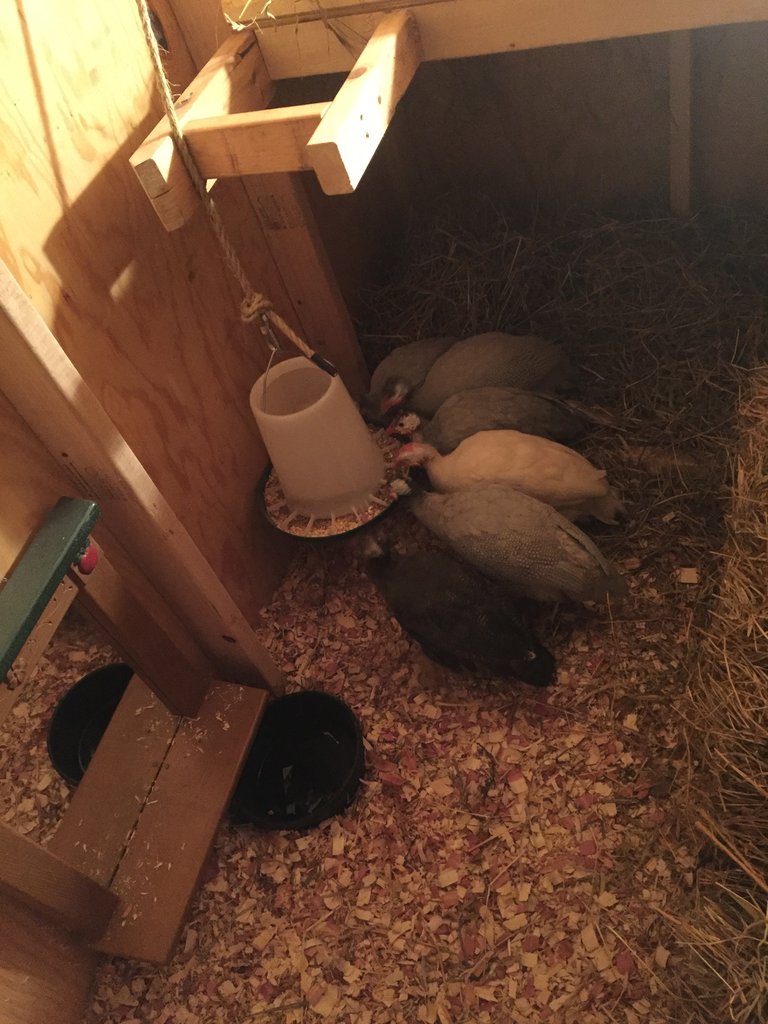
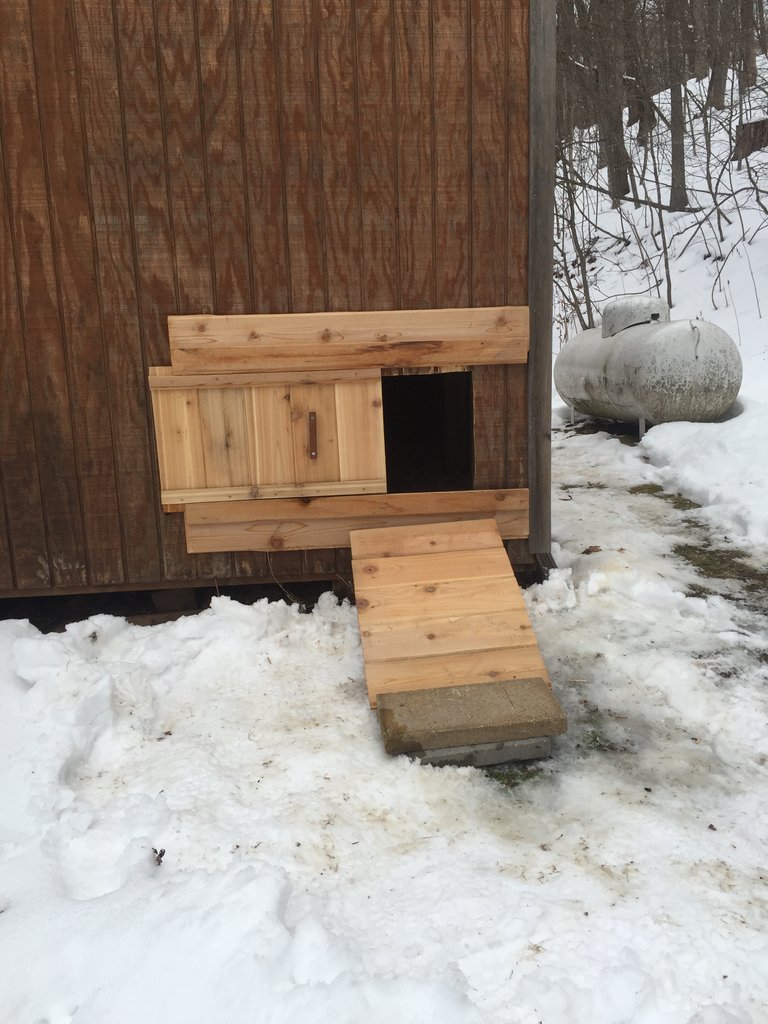
(please don't think of me trying to hijack your post =p I really respect you as a homesteader and steemian and only want to try to share anything that might help like I would if you were my neighbor!)
As the weather got colder I would put down a layer of hay/straw because that makes for the best winter insulation (air gaps in between the layers of straw, also the decomposition of the straw emits a little heat) In wisconsin I don't think we ever got to 30 or 40 below but we got to 20 below, and I never lost a bird in winter. I actually had chicks born at the end of winter that a hen hatched outside in the coop from eggs. I had to bring her food (cracked corn for warmth and sliced up grapes to keep her hydrated) cause I don't think she ever got off those eggs except to make a quick run downstairs to poop and grab a quick drink. Also in winter I would pretty much give the birds as much cracked corn as they wanted because that has the most calories and keeps them warmer. I got more eggs in the winter than I did in the summer.
It's messier cause it's a lot harder to scoop off bird droppings from hay than shavings but not to brag but my chickens and peacocks were "clean" i.e. they would choose a spot to poop in and that made cleaning easier. Guinea fowl: forget it.
Since heat rises, the heat that the chickens were putting off from below the peafowl would warm their floor. Not a whole lot, but it's those little things that when added up, count the most.
You can see that I had a branch perch for them and then nesting "shelves"
The thing that keeps them warmest is when they cuddle together. Some would choose to cuddle on the branch, and the rest were able to cuddle on the shelves. When it came to laying eggs they would just take turns laying in the corner shelves usually. And some of them didn't care about having that "cozy" spot and would just use a slot in the middle of the shelf.
Again, by designing in a way so that the chickens (and peafowl) lived vertically all on one side of the shed, this kept that side of the shed significantly warmer. Never even had a problem with frostbit combs. here's my winter mama and her chicks
You can see at that point that I had moved the heat lamp underneath the bottom platform which made it a favorite spot to roost above and then made another warm spot below.
Honestly, the chickens didn't go outside if it was below freezing. They had no interest in it. So in winter I would just set up the feeding tray inside, then clean up around it regularly. I built a weighted wooden container to hold a rubber water bowl tightly so that they couldnt knock it over and make an ice mess, and then it made water changes easy: just stomp the ice out of it outside, and then pour warm water from a gallon jug inside. They'd do all their drinking for the day before it froze, and pretty much drink almost all of it.
I actually got tired of messy hay so instead I started searching for the biggest curliest wood shavings that i could fine. (bigger shavings mean bigger air gaps, they don't get packed tight like fine shavings) if you can't find large pine shavings, you can mix in cedar shavings which are always large.
As to insulating the floor, if the walls and ceiling of your coop aren't insulated, then it is pointless. But keeping it off of the ground is still important to keep the boards dry and prevent dampness from building up.
The picture above is from before I jacked the shed up and raised it another ten inches and found just gobs of wet nasty crap under it that had started to rot the bottom. Lucky nothing too serious so raising it saved a lot of future work. When I put in the second shed, I started off with a good raised foundation.
For a while I just had poly sheeting stapled to the floor which worked great as a lining but eventually pulled it out because the chickens would get startled, take off, and slip and fall on the poly and I felt sorry for them.
Hope that some of this helped! When I did chickens I had already read everything I could but still innovated a lot of ways to do it even better that worked really well for me, so hopefully at least something will give you an idea or two, since I know raising chickens in the harsh Alaskan winters must be a giant challenge.
Edit: as far as ventilation, soooo important. Make sure you are putting it OVER the heads of the highest spot they will roost at. So right up along where your walls meet the ceiling. That way, drafts will not be hitting the birds. Also, you can arrange them in a way so any cross-drafts between vents aren't going over birds but instead around where they roost.
But if you aren't venting all that wet respiration air, the coop is only getting colder for the birds no matter how much else you are doing right. Dry+cuddling+high calories=warm
I don’t know how to start this without sounding like an ass.
So, I have R-30 in the ceiling, R-15 walls, and I spray foamed the floor when we built it.
We might have to jack the floor, I agree on that. This past winter we had snow and run off that actually came up to the bottom of the base boards. I was very worried, hubby shrugged it off. 👎
It is very hard to get large pine shavings here. There are a few saw mills but most don’t sell shavings as far as I know.
We do use straw in the coop most of the time. But when it’s $20 a bale it becomes very pricy. Then geese are very sensitive when it comes to the bacteria that grow on straw when it gets wet. So that is now a no go.
I was thinking of an arctic entry inside the coop.
Maybe a shelf under the roosting bars, with a box that goes around the doggie door. Then a heat light like you did under it.
The ventilation I have is one hole in the very top of the man door(use to have a screen to keep the wasps out, but the dust clogged it) and the doggie door.
The man door sucks. We made it. It has a lot of gaps. Also the hubby never got around to finish insulating the door of the coop... So I am playing catch-up on that too. Trying to figure out how to mount and insulate it. I’m thinking that since the door is off already I might as well spray foam it, hang the door foam side out. Damn goats eat everything, they eat my plywood... Anyways. So I also have to switch the hinges around.
We have a heated water float/sink that we use for their water. We have a black rubber bowl too, two different sizes. We noticed the larger the bowl the worse the heater preformed. So we switched to a smaller bowl, and fill their water daily with hot water.
When we built it we had power cables run to it and set up. But my hubby hasn’t hooked it up for me. I guess I will have to do that too, if the goats haven’t eaten the wires.
Sigh😔
No need to get the kid gloves out to handle me =p
I know you have to be very smart and resourceful to make it where you are, I'm just monologuing here =p
Sounds like you have it well insulated, but honestly (and I don't know what you could do aside from building more shelters) it sounds like your shed is seriously over-crowded and definitely under-ventilated. Geese are incredibly messy, goats are also messy and also destructive. And birds have lungs that are very sensitive to infection from bacteria and molds that can thrive in an over-wet environment. When I ran power to my shed I ran it through steel conduit to protect it from rodents. It was just an extension cord from the house, drilled through the bathroom wall into below the sink vanity.
I know most of you Alaskans have your own chainsaws. Maybe something that you could do is start collecting your chainsaw shavings to supplement, and then dry and store them for winter. I would do that, along with collecting pine needles again storing and drying them in 50 gallon buckets. Smells great, and is free
I would also hit up all the local woodworkers/cabinet makers/mills a lot of them throw their shavings away. So after doing all that, the cost of buying bales of horse bedding wasn't too bad. Again it depends on what is available to you, i understand.
If you ever need my input on anything let me know I'd be happy to help you try to problem solve or design. If I was there I'd just bring my tools over and we'd build more shelters for you =)
See you know what I need! I have been saying for awhile now that I need to seporate my goats from the coop. But I will admit my goat has separation issues from the chicken yard. I tried to tether her out to get greens, she broke her collar and ran for the yard.
My male goat has his own house made from a broken freezer. I need to find something like that for her and her baby.
But the problem is the two got together, again 🤦♀️ So I might have winter babies, I hate having winter babies.
I do need to bust out a plan, soon. I can do wood working. Grew up in a wood shop, and took wood shop in middle school.
🔲 I would have to decrease the door size of the existing coop, but make it so my turkeys and goose can still get in.
🔲 Have it enclosed, insulated and off the ground.
🔲 Goat resistant.
🔲 Big enough for her to kidd when she is a twat 😒
i think that’s it...
I would like to use plastic pallets for a base, maybe make it two pallets long, 3-4 foot high. That way it’s not to large of an area to heat, smaller areas are easier to heat.
I agree on the ventalation, but even my house vents ice up in the winter. I could make two or three more vents in the door before I spray foam it.
first I'm gonna show you the doors I made for my coops. For each there was an inner and outer door, so they could be summer ventilation or shut off in winter.
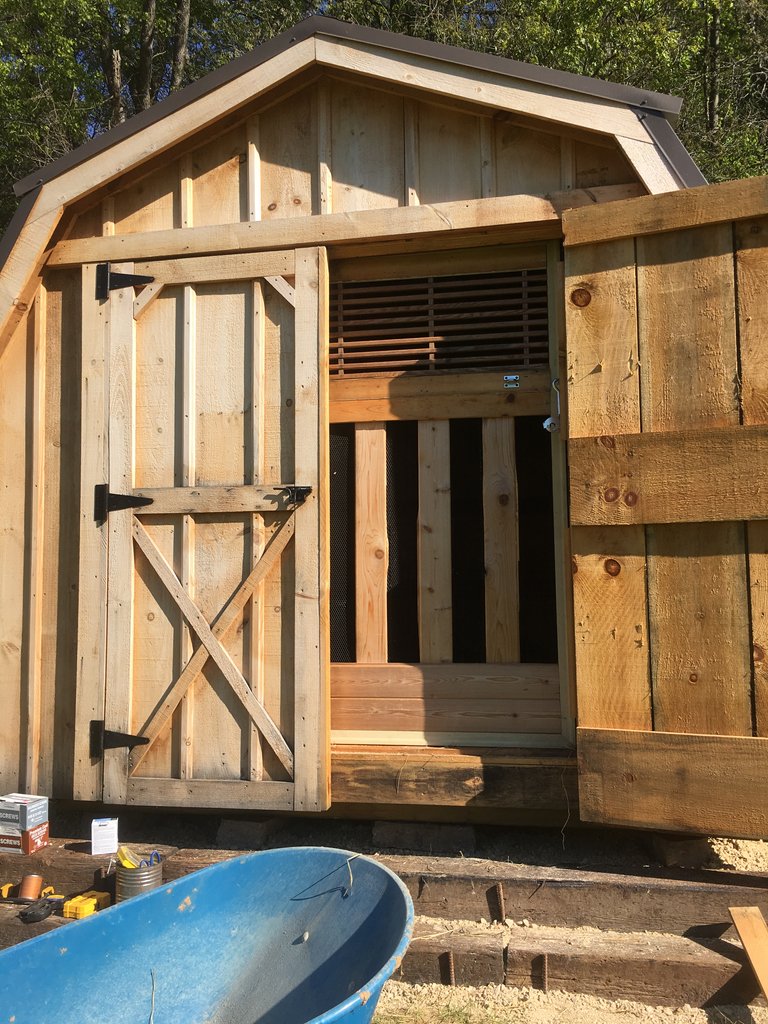
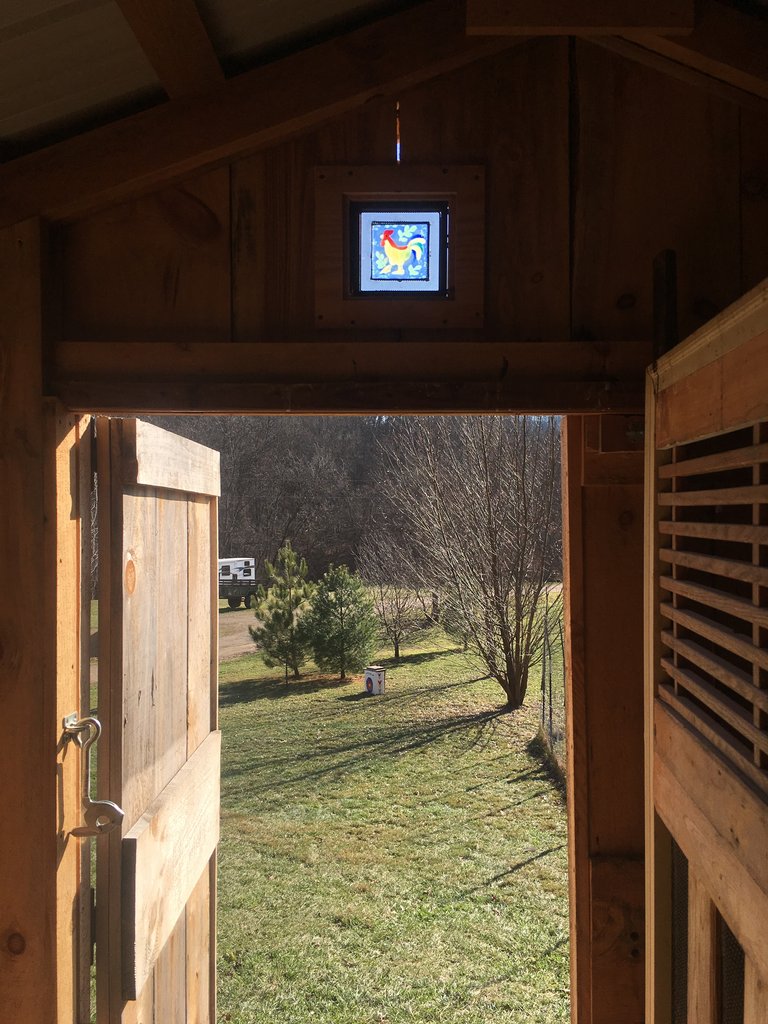
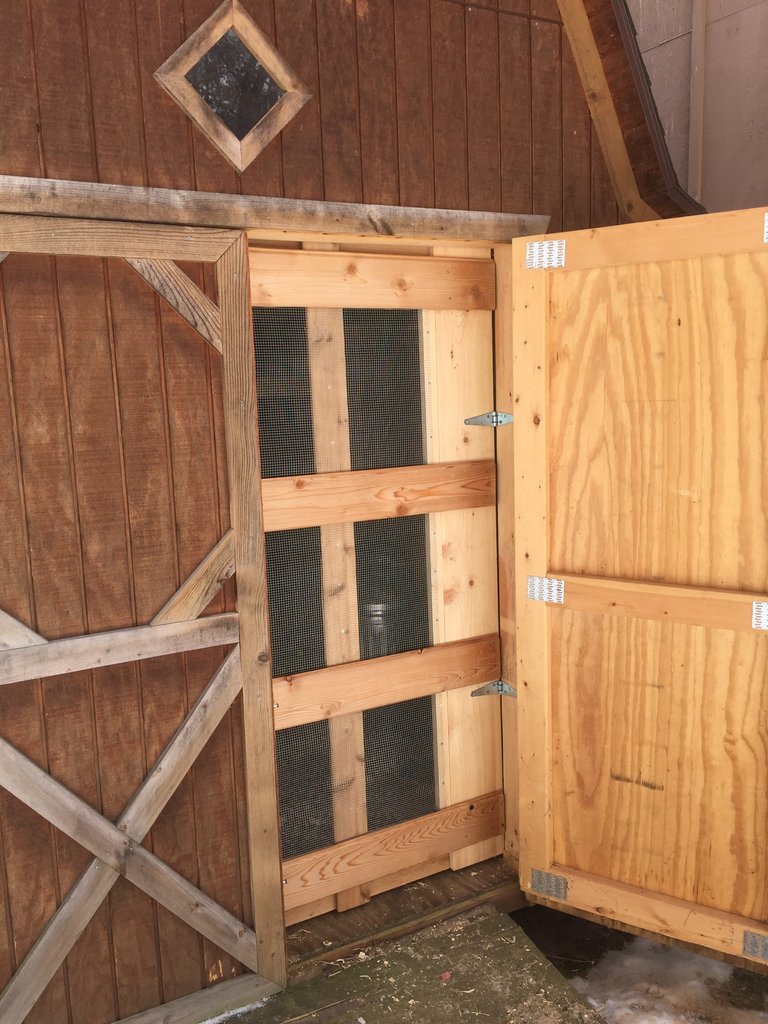
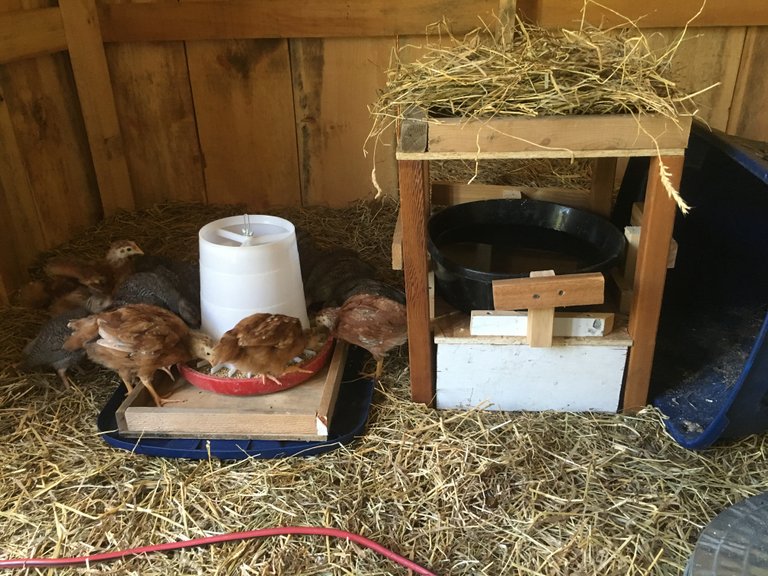
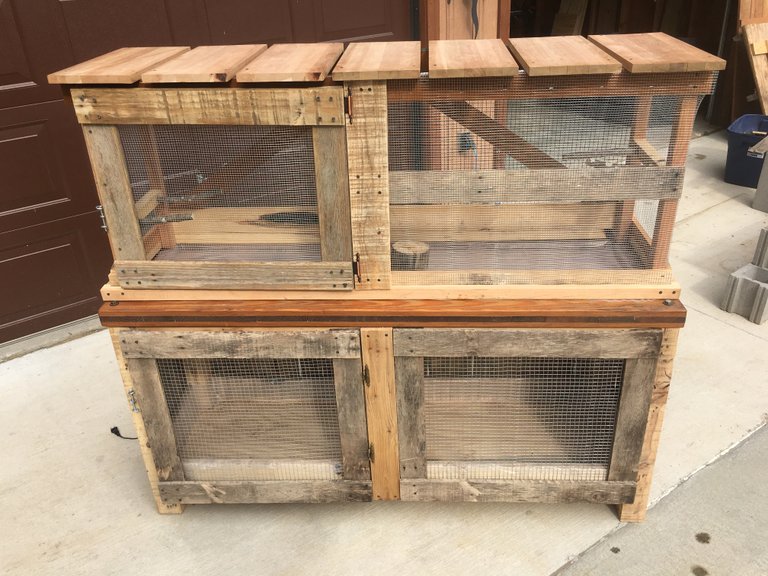
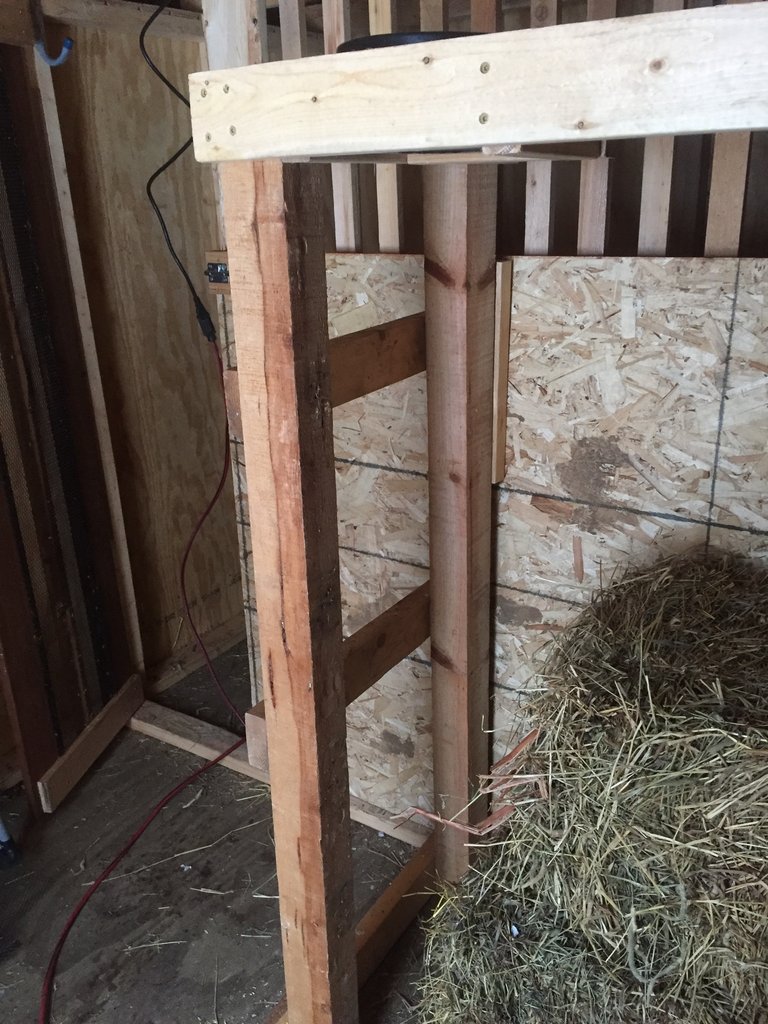
Here is one of the bowl holders i mentioned
2-stage chick incubator i built they'd stay in this until they had their full double feather coats grown
Pretty much everything I did i used with scrap or pallet wood if i could
I didn't know if you could tell from first pictures but i had the chickens in a complete separated gated off enclosure within the shed. I was actually considering keeping goat in the front of the shed but never got around to it. All the same, it kept the male peacock away from them.
The black wire I used for the doors was gutter screens i found tossed out in the woods
The wire for the chick incubators is salvage from a garden that got pulled out.
All the hardware and most of the fasteners i used was salvage.
If you are going to build your lady goat mama-to-be her own home, pallets could be a great idea. I've seen entire structures built from pallets, hardwood pallets are the best. I was thinking that even if the best you can get up is a rough frame with a door, that you could improvise walls and roof by lashing evergreen tree boughs to the outside that could be weatherproofing and insulation and get you through one more year at least until you build a second structure, and then could serve as a goose shelter.
Another quick fix i've seen people do where I live is use old beat up mobile homes and travel trailers that they pick up for free or next to nothing and use those as bird coops and animal housing. Not sure what your local market is like. I loved your freezer house for your male goat =D I've seen that done around here on a smaller scale for outdoor cats.
It sounds like from your measurements what you really need is just a calf warmer situation which shouldn't be hard to do.
I'd watch your local market for other things people are throwing out that could be purposed. I'm thinking especially large cabinets from shop/garage/kitchen renovations. Old still serviceable roofing is usually thrown out too. Also not sure how secure it needs to be (what your local predator situation is like) but a lean-to situation against your current existing shed might be an option to consider. Had I stayed at the location pictured long enough, I was going to end up building add-ons to the existing sheds. Easy reasons of, they were already on flat drained ground and were stable structures with power already run to them. I had planned on keeping geese and ducks and since both need water to eat and make a damned mess everywhere they are i was going to have them in separate duck-happy housing adjacent to the coops. Instead, my ducks decided they wanted to stay in their pond at night, three got grabbed by predators in one night, and the last fool got grabbed a week later.
Finally: have you taken winter temperature readings from inside your coop to determine how much warmer your insulation is actually keeping it? Again, I've never lived that far north so I don't know how much that extra 20 degrees of cold matters, but none of my sheds had any insulation, just the measures that I told you. So I'm kind of curious how well your insulated sheds work.